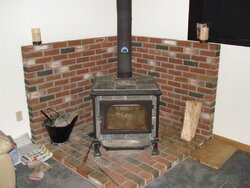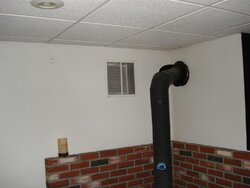Hey All,
My Wife and I purchased a house in Nov with a fairly newer Mansfield in the finished basement. The previous owner had a ducting system and fan installed inthe wall above the stove that distributes the warm air to the first floor. It seems to work pretty well when the stove is going well.
Thats the issue here, I cant seem to get what I think is good heat out of the stove.... and it seems to go through wood at an incredible pace. I have already burned 2 cords since Dec 1st! which seems like a lot to me. I only fire it up when I get home from work and load it up for an overnight burn. I dont burn it during the day.
I have a burn indicator on the pipe, I cant seem to get it to go much above 300. I typically leave the primary air control wide open and it still does not go above 300.
Should I be more concerned with the stove top temp?
Should I be closing the primary air control down to achieve what I heard is a "secondary Burn"
Should I consider burning 24/7, is that more efficient with these slow to heat soapstone stoves.
Help!! - I read the manual but it doesnt seem to spell out all the tips and tricks.
Sorry for all the questions like I said I am new to heating with wood, but I want to get the most out of it.
Thanks
My Wife and I purchased a house in Nov with a fairly newer Mansfield in the finished basement. The previous owner had a ducting system and fan installed inthe wall above the stove that distributes the warm air to the first floor. It seems to work pretty well when the stove is going well.
Thats the issue here, I cant seem to get what I think is good heat out of the stove.... and it seems to go through wood at an incredible pace. I have already burned 2 cords since Dec 1st! which seems like a lot to me. I only fire it up when I get home from work and load it up for an overnight burn. I dont burn it during the day.
I have a burn indicator on the pipe, I cant seem to get it to go much above 300. I typically leave the primary air control wide open and it still does not go above 300.
Should I be more concerned with the stove top temp?
Should I be closing the primary air control down to achieve what I heard is a "secondary Burn"
Should I consider burning 24/7, is that more efficient with these slow to heat soapstone stoves.
Help!! - I read the manual but it doesnt seem to spell out all the tips and tricks.
Sorry for all the questions like I said I am new to heating with wood, but I want to get the most out of it.
Thanks




